Text
THE WOMEN
unCovered Review by Emily Monte, ACLS Absecon Branch

Why can't a woman be a hero as well?
This question alters everything for Frankie McGrath and challenges the life plans her family has set out for her. They expect her to marry and have children, conforming to the norms of the early sixties. However, she decides that she, too, can be a hero, serving her country and making her family proud, just like her brother did. She applies to the Army Nurse Corps to follow in her brother's footsteps. Her conservative and highly respected family doesn't support her decision and, when a tragic piece of news arrives unexpectedly, Frankie's life takes a sharp turn before she embarks on her earth-shattering journey.
Soon, she finds herself amidst chaos and destruction, realizing that as a young, innocent, and inexperienced woman, she's like a fish in a bottle tossed into a dangerous ocean teeming with sharks. Within a short span of time, she becomes terrified, numb, and exhausted, navigating days where her heart breaks as she witnesses soldiers younger than her brother losing their lives and civilians becoming expendable amidst the chaos. As Frankie edges closer to collapse, nearly drowning in sorrow, her friends Barb and Ethel extend a lifeline, offering enough emotional support to keep her from giving up.
THE WOMEN, by Kristin Hannah, takes you on a 20-year journey with Frankie, spanning two parts of her life as she struggles to save herself. She risks her life in the process, and upon her return, she realizes that she's not regarded as a war hero like the men who fought in combat. People avoid discussing the war, and even her own family treats her as though she's done something to embarrass them, something they'd rather not acknowledge. During the day, she's compelled to blend into the community, resuming where she left off before the war, while at night, she battles her nightmares and the clutches of PTSD. She comes to understand that she's not the proud, ideal girl her family wanted her to be and never can be. Eventually, she gives in.
Frankie's painful journey, marked by losses, battles with addiction, and anger toward those who betrayed and disrespected her, is portrayed with remarkable realism. She's one of the women from the war whose stories need to be told, remembered, and respected. Will she overcome her inner demons? Will she learn to heal from her pain, forgive those who worsened her suffering, embrace her flaws, and confront her fears that she's afraid to share with others? Will she ultimately find the peace she's searching for? Read her story to uncover the answers.
This might be one of my favorite works by Kristin Hannah. After reading her closing note, I gained a deeper appreciation for the years of hard work she put into creating these vivid characters and crafting realistic descriptions of war zones, leading us on this unforgettable journey.
0 notes
Text
NUBIA: THE RECKONING
UnCovered Review by Collette Jones, ACLS Egg Harbor City Branch

Omar Epps and Clarence A. Haynes' NUBIA: THE RECKONING picks up directly from the pulse-pounding cliffhanger of THE AWAKENING, thrusting Zuberi, Uzochi, and Lencho into a dystopian New York City where their newfound Nubian powers become the target of a ruthless government. While the sequel doubles down on action and world-building, it stumbles slightly in character development and narrative coherence. The world-building flourishes in this sequel. We delve deeper into the lost history and forgotten magic of Nubia, uncovering secrets that heighten the intrigue. The futuristic dystopia of Tri-State East feels fleshed out, showcasing both its oppressive nature and pockets of resistance. However, some readers might find the world-building elements occasionally overshadowing the character development.
The story explodes with conflicts. Uzochi, hailed as the "Nubian Catalyst," faces not only the power-hungry Sky King but also his own conflicted cousin, Lencho, now a pawn in the government's game. The introduction of an ancient, malevolent force adds another layer of danger, but its connection to the overall narrative feels somewhat forced. The characters grapple with internal conflicts and external pressures. Uzochi struggles with the weight of leadership and the burden of his abilities. Zuberi's loyalty is tested, and Lencho's descent into darkness is explored, albeit not always with the nuance it deserves. The supporting characters, particularly Sandra, offer complexity and depth, enriching the narrative tapestry.
Epps and Haynes deliver action-packed sequences that are sure to keep readers engaged. The final battle is epic in scope, showcasing the full potential of the Nubian powers. The action sequences are undoubtedly thrilling, showcasing the characters' evolving abilities in creative and cinematic ways. Zuberi's command over water and Uzochi's manipulation of energy are particularly well-explored, leading to some truly epic battles. However, the relentless pace leaves little room for character introspection, hindering their emotional growth. Lencho's descent into villainy feels rushed, and Zuberi remains somewhat stagnant, despite her pivotal role.
The world-building shines, expanding on the rich tapestry of Nubian history and culture. We delve deeper into the island's tragic fall and the struggles of its diaspora, adding weight to the characters' motivations. The depiction of a climate-ravaged New York is both bleak and hauntingly beautiful, creating a captivating backdrop for the unfolding drama. Epps and Haynes' writing is clear and engaging, but occasionally falls into exposition dumps, especially when introducing new characters or plot points. The dialogue, however, is sharp and witty, capturing the distinct personalities of the characters, particularly Lencho's humor.
Overall, NUBIA: THE RECKONING is a satisfying continuation, offering a thrilling escape into a world of extraordinary powers and high-stakes conflicts. However, its focus on action comes at the expense of deeper character exploration and a more cohesive narrative. If you enjoyed the fast-paced adventure of THE AWAKENING, this sequel will not disappoint. But for those seeking profound character development and a tightly woven plot, it might leave you wanting more. The novel tackles themes of power, identity, and the fight against oppression. It echoes real-world struggles for justice and equality, adding depth to the fantastical setting.
0 notes
Text
These Silent Woods
UnCovered Review by Debbie Brahmi, ACLS Pleasantville Branch

Do not judge this book by its cover! Kimi Cunningham Grant’s THESE SILENT WOODS is not your run-of-the-mill psychological thriller. This is a tale of a father’s love for his daughter that will tug at your heartstrings and leave a lump in your throat.
In this very emotional story Cooper and his young daughter Finch have been living under the radar in an isolated cabin in the woods with no electricity for the past eight years, ever since she was just a baby, but Finch is starting to ask too many questions that Cooper is not willing to answer. No one knows where they are, except for Scotland, a mysterious neighbor, and Jake, a trusted friend who delivers food and supplies to the cabin once a year.
When Jake fails to show up as planned, Cooper must venture outside his comfort zone and drive to the nearest Walmart (with Finch hiding under a blanket) and purchase what they will need to survive for another year. A close encounter with a police officer leaves Cooper a bit shaken, but things really start to fall apart when a stranger is spotted wandering around near the cabin, a young woman, and Finch becomes obsessed with meeting her.
Cooper is not ready to leave the cabin and risk losing his daughter, maybe forever, but Finch, unaware of Cooper’s past sins, is giving him no choice.
What’s a father to do?
0 notes
Text
Just Because: A Breezy Ode to Life's Contradictions
unCovered Review by Collette Jones, ACLS Egg Harbor City Branch

Matthew McConaughey's debut children's book, JUST BECAUSE: A BREEZY ODE TO LIFE'S CONTRADICTIONS, is a charming and thought-provoking exploration of life's complexities wrapped in a playful rhyming package. The book celebrates the beauty of "just because" moments, where one thing can be true, and its opposite can also hold merit.
Through vibrant illustrations and McConaughey's signature Southern drawl (downloadable audiobook available, bit.ly/42dGMLV), we meet a cast of characters demonstrating diverse perspectives. A child who loves reading may also be a messy eater, and a clumsy friend might be a loyal confidante. These dualities are presented not as contradictions, but as facets of a multifaceted world.
The book's strength lies in its simplicity. McConaughey doesn't preach or moralize. He simply observes and invites readers to do the same. "Just because you stumble sometimes, doesn't mean you can't run," he writes, encouraging acceptance of imperfections and embracing growth.
JUST BECAUSE isn't without its flaws. The rhyming prose can occasionally feel clunky, and the message, while valuable, might be too nuanced for very young children. However, for older kids and adults, it's an insightful reminder that life is rarely black and white.
The book's true magic lies in its ability to spark conversations. It invites readers to question assumptions, consider alternative perspectives, and celebrate the messy, beautiful tapestry of human experience. Whether you're a parent reading with your child or an adult rediscovering the joy of simple truths, JUST BECAUSE offers a refreshing perspective on life's contradictions, reminding us that sometimes, the most meaningful lessons are learned not in right or wrong, but in the vibrant "just because" in between.
0 notes
Text
Curious Tides
UnCovered Review by Nancy Wessler, ACLS Mays Landing Branch
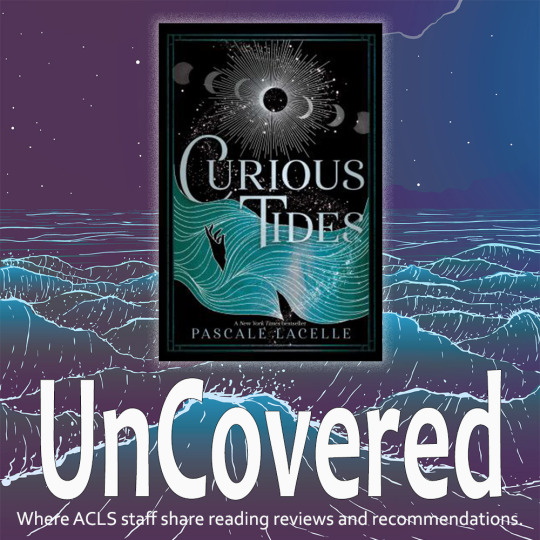
A student at the prestigious Aldryn College for Lunar Magics, Emory has never felt very exceptional. But after intruding on a mysterious magical ritual, Emory awakens to discover that it has gone terribly wrong, and everyone involved, including her best friend, Romie, has died--everyone, that is, except for her. Exceptional.
Guilt ridden but determined to understand what happened, Emory returns to school and soon discovers that her magic has changed into something far more powerful and dangerous than the mediocre healing powers she has always possessed. Her search for answers soon leads her to the shadow-gilded world of secret societies, forbidden magic, and the dangerous hope that there may be a way to bring Romie back. Meanwhile, Romie's older brother, Baz, long an outcast at school, is also trying to unravel the mystery that stole his sister's life--and to keep Emory from befalling a similar fate.
CURIOUS TIDES by Pascale Lacelle is a pitch-perfect dark academia fantasy, featuring a unique, fully-realized magic system (based on lunar-tidal alignment) and a cast of delightfully damaged protagonists and antagonists alike. “The vibes,” as they say, are immaculate, and a strong sense of atmosphere grounds the story through its slower early chapters. The action quickly picks, however, once Emory and Baz dive deeper into the mystery, and the plot's various currents begin to collide. There's romance and betrayal and dark secrets to uncover. There's heartache and hope and rich mythology to explore. There's also a second book planned, so while most of the questions raised in this book are answered, be prepared to anxiously await the sequel. Recommended for older teens and adults.
0 notes
Text
Artifice
UnCovered Review by Nancy Wessler, ACLS Mays Landing Branch

It's 1943, and eighteen-year-old Isa de Smit has been struggling to make ends meet since the Nazis shut down her family's art gallery in Amsterdam. She's also caring for her widowed father, a brilliant artist with a knack for copying the Masters, who is becoming ever more erratic. Desperate to keep her home, she decides to sell one of her father's paintings, successfully passing it off as a Rembrandt--and tricking Hitler's agent into purchasing it.
In so doing, however, she captures the attention of Michel Lange, a young Nazi soldier in charge of assisting with the sales. He wants to desert and is willing to blackmail Isa into helping him do it. Meanwhile, Isa's friend and Dutch Resistance member, Truus, also wants Isa's help. She's working to smuggle Jewish babies out of the city and needs money for the bribe that will assure they get to safety.
Isa resolves to aid Truus, but to do so she'll need more than the money earned from selling the fake Rembrandt. She'll need to craft and sell another forgery. This means navigating both the world of reviled collaborators and that of Resistance conspirators. It means learning how to truly spot a fake. It means trusting Michel Lange. But for the lives that could be saved, isn't the risk worth it?
ARTIFICE by Sharon Cameron is a young adult historical thriller that seamlessly blends fact and fiction to create a riveting page-turner that is evocative, emotional, and beautifully written. It is at least partially inspired by the true stories of Han Van Meegeren, a master art forger who famously sold fakes to Hermann Goering, and Johann Van Hulst, a school director credited with saving over 600 Jewish children from death--as well as multiple real life Dutch Resistance heroes. It offers a fascinating and heartbreaking glimpse into life under occupation--the constant tension of distrust and subjugation--as both culture and lives are stolen. However, it is ultimately a story about finding beauty in an ugly world and the chances worth taking to un-make so many wrongs. An altogether compelling read.
0 notes
Text
White Fragility: Why it's so hard for white people to talk about racism
UnCovered review by Collette Jones, ACLS Egg Harbor City Branch
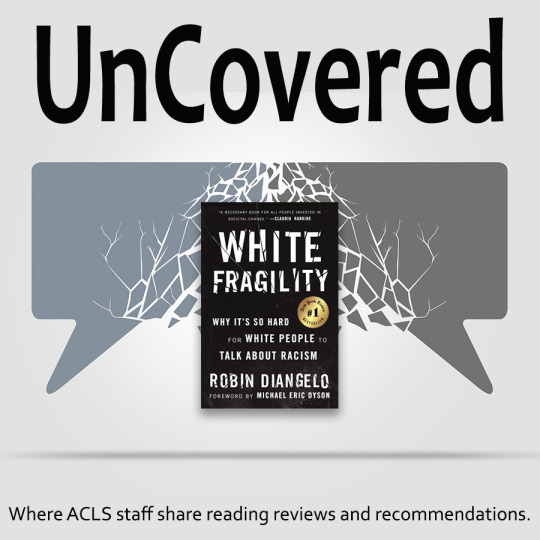
In WHITE FRAGILITY: WHY IT'S SO HARD FOR WHITE PEOPLE TO TALK ABOUT RACISM, Robin DiAngelo tackles the uncomfortable terrain of white defensiveness when confronted with race. Her book, while short, packs a powerful punch, exposing the hidden mechanisms that shield white people from genuine engagement with racial issues.
DiAngelo's central concept, "white fragility," refers to the defensive moves white people often employ when their racial beliefs are challenged. These moves, ranging from anger and tears to silence and argumentation, serve to reassert white comfort and deflect responsibility. The book meticulously dissects these behaviors, illuminating their insidious role in perpetuating racial inequality.
DiAngelo skillfully weaves personal anecdotes with research and critical theory, offering a nuanced understanding of white fragility's origins. She argues that it stems from a racialized society that elevates whiteness and insulates white people from the realities of racism. This lack of awareness fosters a fragile sense of racial identity, easily threatened by any hint of critique.
The book's brilliance lies not in blaming white people, but in urging them to recognize and dismantle these defensive patterns. DiAngelo encourages introspection, self-education, and a willingness to sit with discomfort. She emphasizes the importance of active listening and learning from people of color, rather than seeking to silence or invalidate their experiences.
While WHITE FRAGILITY is undoubtedly a challenging read, it's a necessary one. It's a mirror reflecting the ugly reality of how we, as white people, often hinder progress in racial justice. It's a call to action, urging us to move beyond fragility and embrace the discomfort that leads to genuine growth.
However, the book is not without its limitations. Some might find DiAngelo's focus on white fragility limiting, neglecting the complexities of racism and the agency of people of color. Additionally, the prescriptive nature of some solutions could be interpreted as overlooking the unique contexts and experiences of individual white people.
Despite these limitations, WHITE FRAGILITY remains a crucial contribution to racial discourse. It's not a feel-good read, but a necessary one. It's a book that begs to be discussed, debated, and ultimately, internalized. For anyone seeking to understand the roots of white resistance and truly engage in racial justice work, WHITE FRAGILITY is a powerful starting point.
DiAngelo, a white anti-racism educator, doesn't shy away from discomfort. She dissects the insidiousness of "microaggressions," the seemingly innocuous comments or actions that chip away at a person's sense of belonging. She exposes the myth of "colorblindness" as a form of denial, and challenges the narrative of white innocence, forcing readers to confront the legacy of racial advantage they inherit.
The book's brilliance lies in its specificity. DiAngelo delves into real-life scenarios, from casual conversations to heated debates, illustrating how white fragility manifests. She doesn't offer easy answers or forgiveness. Instead, she demands accountability, urging white readers to engage in the arduous process of self-education and unlearning harmful racial biases.
DiAngelo's prose is clear, concise, and laced with empathy. She acknowledges the pain racism inflicts on both parties, recognizing the vulnerability white fragility stems from. This isn't about demonizing white people; it's about dismantling the system that benefits them at the expense of others.
WHITE FRAGILITY isn't for the faint of heart. It's a call to action, an invitation to dismantle the house of cards we've built on racial denial. It's a book that will make you squirm, argue, and hopefully, reflect. It's a necessary read for anyone who wants to be part of a more just and equitable society, starting with the introspection it demands from those who hold the most power to change it: white people.
At just over 200 pages, it's a compact yet powerful read that will leave you both challenged and empowered. If you're truly committed to racial justice, pick up WHITE FRAGILITY. It might shatter your mirror, but the reflection staring back is the first step towards genuine change.
0 notes
Text
Conflict: The Evolution of Warfare from 1945 to Ukraine
UnCovered review by Collette Jones, ACLS Egg Harbor City Branch

CONFLICT: THE EVOLUTION OF WARFARE FROM 1945 TO UKRAINE is a sweeping and authoritative history of warfare from the end of World War II to the present day co-authored by General David Petraeus and historian Andrew Roberts. The book examines the major conflicts of the past seventy years, including the Korean War, the Vietnam War, the Gulf War, the wars in Iraq and Afghanistan, and the ongoing war in Ukraine. Petraeus and Roberts draw on their own extensive experience in the military and in academia to provide a unique and insightful perspective on these wars and on the evolution of warfare more broadly.
One of the strengths of CONFLICT is its scope and ambition. The book covers a vast amount of material but does so in a clear and concise way. Petraeus and Roberts avoid getting bogged down in unnecessary details, and they focus on the most important lessons that can be learned from each conflict. They also do a good job of explaining the complex geopolitical and technological factors that have shaped warfare in the post-war era.
Another strength of the book is its balance between the strategic and the operational levels of war. Petraeus and Roberts are both experts in military strategy, but they also have a deep understanding of the realities of combat. They are able to explain the complex strategic decisions that are made by leaders in wartime and also provide insights into the experiences of soldiers on the ground.
One of the most important lessons that Petraeus and Roberts draw from their analysis of recent conflicts is that warfare is becoming increasingly complex and challenging. They argue that traditional military forces are no longer enough to win wars in the 21st century. Instead, they advocate for a more holistic approach to warfare that combines military force with other instruments of power, such as diplomacy, economic sanctions, and information warfare. In his book CONFLICT: THE EVOLUTION OF WARFARE FROM 1945 TO UKRAINE, Petraeus writes:
"Conflict is a broader term than warfare. It can encompass a wide range of situations, from peaceful competition to violent conflict. Warfare is a subset of conflict that involves the use of armed force to achieve political goals."
Petraeus goes on to argue that conflict is a complex phenomenon that is often driven by underlying social, political, and economic factors:
"Conflict is rarely simply a matter of 'good' versus 'evil.' It is often rooted in deep-seated grievances, historical disputes, and economic rivalries. These underlying causes must be addressed if we are to achieve lasting peace."
Petraeus emphasizes the importance of non-military approaches to conflict resolution:
"Military force can be necessary to deter or respond to aggression, but it is often more effective to address the underlying causes of conflict through diplomacy, economic development, and other non-military means.”
In short, Petraeus sees conflict as a more complex and nuanced phenomenon than warfare. He argues that it is important to understand the underlying causes of conflict in order to develop effective strategies for conflict resolution.
CONFLICT is an essential book for anyone who wants to understand the evolution of warfare in the post-war era. It is also a valuable resource for policymakers and military leaders who are grappling with the challenges of fighting and winning wars in the 21st century. Recommended for anyone interested in the history of warfare, military strategy, or current events.
1 note
·
View note
Text
Holly
UnCovered Review by Debbie Brahmi, ACLS Pleasantville Branch

Fans of Stephen King will remember meeting Holly Gibney for the first time as a minor character in the trilogy MR. MERCEDES, FINDERS KEEPERS, and END OF WATCH. She reappeared later as a major supporting character in THE OUTSIDER and a main character in the novella LET IT BLEED. Holly is an “obsessive compulsive with an inferiority complex” but in King’s newest book, she is the star of the show!
Holly is now the owner of the Finders Keepers detective agency, and she is determined to crack the case of a missing young woman, despite the fact that she was planning to take some time off, due to the fact that her partner, Pete, has Covid, and her “very complicated” mother has just died.
Holly inadvertently stumbles upon several other missing person cases that might be related to the disappearance of the young woman, Bonnie Dahl. The evidence slowly starts to implicate octogenarians Rodney and Emily Harris, semi-retired college professors, who are extremely devoted to one another, and, of course, who are hiding something evil and depraved in their basement.
Unlike most of Stephen King’s other novels, there is nothing “supernatural” going on in HOLLY, this one is just a very suspenseful mystery/horror/detective story, which will absolutely make your skin crawl. And, if you are not familiar with the other “Holly” books, this HOLLY can be read as a stand-alone novel. Enjoy!
1 note
·
View note
Text
The Armor of Light
UnCovered review by Collette Jones, ACLS Egg Harbor City Branch
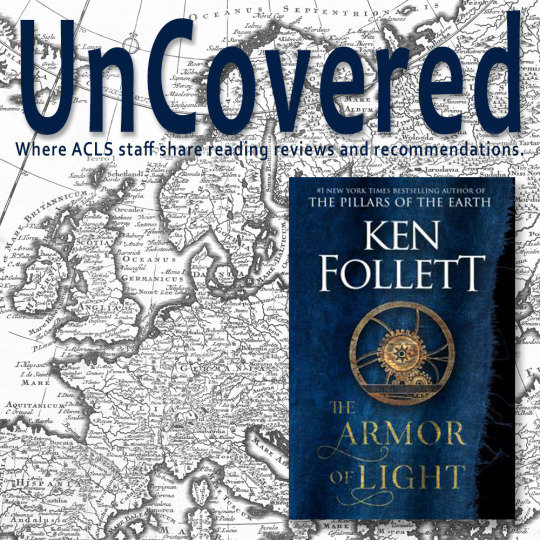
Ken Follett is a master of historical fiction, and his latest Kingsbridge novel, THE ARMOR OF LIGHT, is no exception [bit.ly/46qnG6E]. Set in England and France during the late 18th and early 19th centuries, the book tells the story of a diverse cast of characters as they navigate the tumultuous times of the Industrial Revolution and the French Revolution. The book begins in 1791, with the French Revolution in full swing. Follett introduces us to three main characters: Eliza Williams, a young woman from Kingsbridge, England, who is traveling to France to join her husband; René Bouchard, a French soldier who is fighting for the Revolution; and Carla Lavidère, an aristocratic French woman who is fleeing the violence of the Revolution.
Eliza's journey to France takes her through the heart of the Revolution, and she witnesses firsthand the brutality and chaos of the time. When she finally arrives in Paris, she finds that her husband has been killed. She is then taken in by René, who helps her to find a new life in France. Carla, meanwhile, is forced to flee her home when it is attacked by revolutionaries. She takes refuge with a family of peasants, but she is eventually captured and imprisoned. While in prison, she meets René, and they fall in love.
The three main characters are all drawn into the conflict between the revolutionaries and the old order. Eliza and René become involved in a plot to overthrow the French government, while Carla is forced to choose between her loyalty to her family and her love for René. In addition to the main characters, Follett also populates his novel with a number of other memorable characters, including: William Hamleigh, a wealthy English factory owner who is determined to crush the labor movement; Rob Jakes, a skilled craftsman who is leading the fight for workers' rights; Patience Lovell, a Quaker woman who is working to improve the lives of the poor; Edward Williams, Eliza's brother, who is a gifted engineer.
First significant fact, it is the fifth and final book in his Kingsbridge series, which chronicles the history of a fictional town in England over the course of several centuries. The series has been praised for its historical accuracy and its ability to bring the past to life. THE ARMOR OF LIGHT is set during the Industrial Revolution and the Napoleonic Wars, two of the most transformative periods in human history.
The novel is also significant for its exploration of themes such as class conflict, religious tolerance, and the importance of education. Follett shows how the Industrial Revolution led to a widening gap between the rich and the poor, and how new technologies such as the spinning jenny displaced workers and led to social unrest. He also explores the tensions between different religious groups, and the importance of religious tolerance in a pluralistic society. Finally, THE ARMOR OF LIGHT is a celebration of the human spirit. It shows how ordinary people can achieve great things, even in the face of adversity. Follett's characters are complex and well-developed, and their stories are both inspiring and heartbreaking.
Follett's descriptions of the new factories and machines, the social unrest and political upheaval, and the battles and sieges are all incredibly detailed and realistic. It explores the impact of technological change on society. Follett shows how the spinning jenny and other new technologies led to the displacement of workers and the rise of a new social class, the factory owners.
You may remember Ken Follett's blockbusting Kingsbridge series that began with THE PILLARS OF THE EARTH, and bestselling title. The Kingsbridge Novels are Ken Follett’s classic historical masterpieces. Set in the city of Kingsbridge, Follett brings his rich expertise to this immersive and epic saga – full of ambition, love, power and family conflict. The story begins in THE PILLARS OF THE EARTH, which centers on the struggles of Prior Phillip and his mason-turned-architect Tom as they attempt to build the greatest gothic cathedral in the medieval world.
The sequel, WORLD WITHOUT END, is set two centuries later and follows the lives of four children who witness two men being killed the day after Halloween. From that moment, their lives are bound together by love and revenge, as they confront the Black Death and the beginning of the Hundred Years War.
The saga continues in the third novel, A COLUMN OF FIRE. Beginning in 1558, it charts the star-crossed romance between Will Willard and Margery Fitzgerald over half a century. Meanwhile, Europe turns against England when Elizabeth Tudor becomes queen and finds herself beset by plots to dethrone her. The Pillars of the Earth, starring Rufus Sewell and Eddie Redmayne, and World without End, starring Cynthia Nixon, have been adapted for television.
1 note
·
View note
Text
Mister Magic
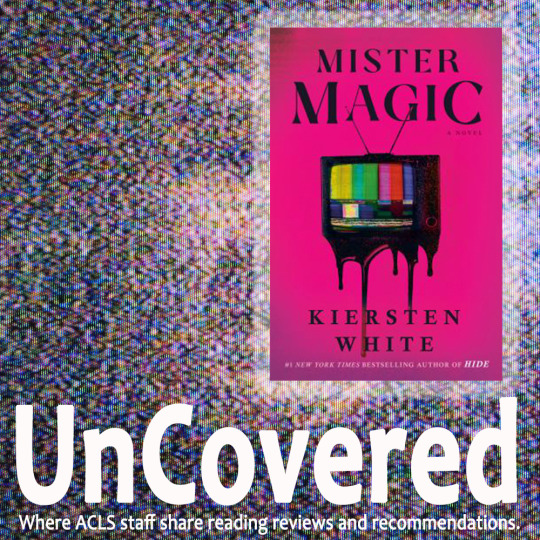
Let me start with a vocabulary lesson. “Analog horror” is a sub-genre of horror fiction that utilizes the aesthetics of VHS tapes and TV broadcasts from the 80s and 90s. It’s basically the quirky younger sister to found footage, but while found footage horror relies on the reactions to the horror off-screen (like how in the Blair Witch Project we never actually see the titular witch, but we see and hear the characters’ reactions) analog is more focused on the slow-burn marriage of uncanniness and dread. It’s a sub-genre that is very unique to the 21st century and very internet-based, and one I am intimately familiar with since I was born in 1997 and came of age alongside its advent on YouTube.
MISTER MAGIC by Kiersten White is amazing because it manages to capture the uneasiness, uncanniness, and fear of analog horror without the added aid of visuals. Centered on the mysterious cancellation of beloved children’s program “Mister Magic,” the novel introduces us to the now adult cast of the show as they struggle with adulthood and find solace in their skewered memories of the show. However, the thing about this show is it doesn’t seem to exist. No recordings of it can be found, no one knows who directed or produced it, and no one remembers what channel it was on. Both cast and cultishly devoted fans alike only have fractured memories of the moral lessons hammered into them by the show. Moral lessons the adult cast now question. Horror aside, MISTER MAGIC is an interesting dissection and critique of children’s programming and modern-day parenting as well as an exploration of childhood trauma. The novel is certainly weird and eccentric- this is horror after all- but at its core it’s deeply emotional, existential, and atmospheric. It’s a must-read for weird book lovers and anyone who grew up reading Creepypastas.
unCovered Review by Samantha LeRoy, ACLS Mays Landing Branch
1 note
·
View note
Text
Through the Wilderness: My Journey of Redemption and Healing in the American Wild
UnCovered review by Marraina Wagner, ACLS Ventnor Branch
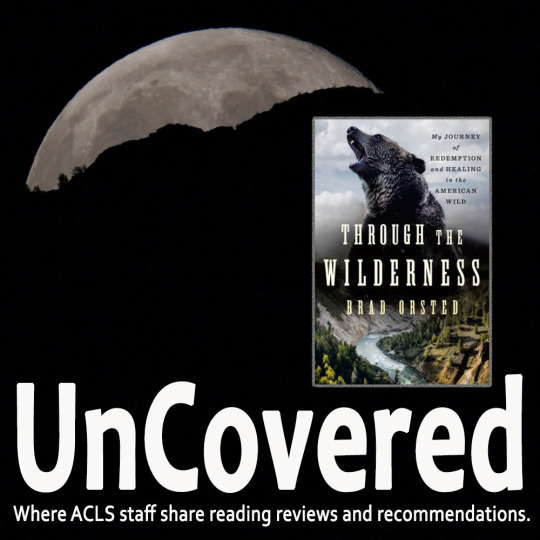
Paradise Valley, Montana…a little over two hours from West Yellowstone is where we end up with our author, Brad Orsted. In his memoir, THROUGH THE WILDERNESS: MY JOURNEY OF REDEMPTION AND HEALING IN THE AMERICAN WILD, he takes us through the battle for his sanity and healing right before he left Michigan for his wife’s new job. From my own personal experience, I know the healing power that the area he takes us to holds for those of us with broken souls.
I was previously familiar with Brad through his work with National Geographic and The Smithsonian Channel as a photographer and videographer. I have also seen his film “The Beast of Our Time.” He won an award for “Best Environmental Film” at the L.A. Documentary Film Festival. I had no idea of his story though.
Brad’s story, in my opinion, is a necessary read for anyone that has suffered child loss, substantial trauma, or addiction.
We meet Brad, two years after the death of his 15-month-old daughter, Marley. Consumed with grief, regret, and guilt, we time travel with Brad through his constant alcohol-fueled, lucid flashbacks, and both suicidal and homicidal wars inside of himself. He longed for answers from his mother and the Michigan police department. We start to understand that his mother was caring for Marley the night of her death. She also waited hours to call the police and immediately stopped speaking to Brad and his sister when this tragic event occurred.
Brad spares us no detail through his chaos and journey of healing in the wilderness of Montana. The path the reader will walk with him is cloaked in darkness, rage, and more profound grief. It’s riveting, relatable, and even offers the reader a sense of healing.
His face to face encounter with a massive grizzly bear opens the flood gates to Brad’s exact moment of revelation. It sets off a chain of events and encounters with more wildlife that have only one explanation: his destiny, which was already etched in the stars for him. Abandoned twin bear cubs teach him about survival, and a wolf pack teaches him about family.
Brad tells us about his friendship with Loren Black Elk in the 90s and how he sought out sanctuary with the Ojibwa in Michigan’s Upper Peninsula on Pine Ridge Reservation right after Marley’s death. He tells us that he still ended up being consumed by his darkness. The grizzly bear encounter reminded him of that time, and he went directly to The Crow tribe to seek advice and healing, again. After his time with the tribe in Montana, we begin to see light peeking thru every page turned.
In closing, I returned my copy with a few accidental tear drops on the pages. I too fled to Montana in early 2021 for healing. I had no idea he took a similar path in the exact places I did. His story touched my heart and soul. I privately emailed him thanking him for being so incredibly open about his pain and his journey. He sends his thanks to the library for the purchase and shelving of his story. He hopes to reach others that have suffered and are in need of redemption. We shared our stories of seeking ourselves in the Wilderness of Montana and the wildlife encounters that changed us forever. Also, the ones we look forward to knowing that our healing is for a lifetime. In my opinion, this book could be a best seller and is an incredible read. I cannot wait to see what he has in store for us in his 2nd book.
0 notes
Text
Lincoln's Last Trial
UnCovered Review by Frank Tomasello, ACLS Mays Landing Branch
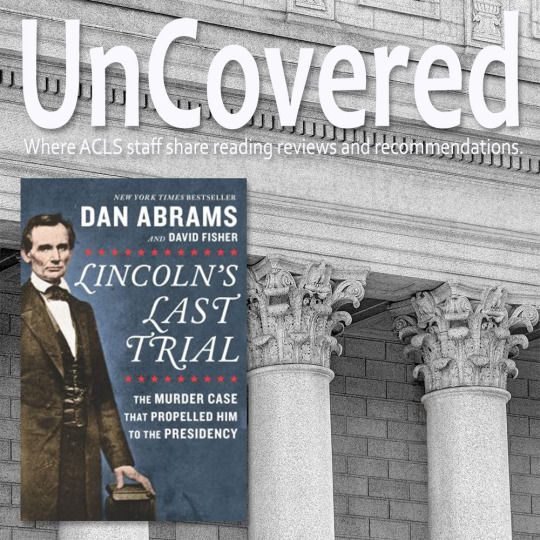
Most Americans are aware that the 16th President, Abraham Lincoln, was an attorney before becoming President. Basically self-taught, with a practice limited to the then frontier of Illinois, little is made of his remarkable legal career. One of the last cases Lincoln tried before moving on to running for President is the subject of this work, LINCOLN’S LAST TRIAL by Dan Abrams and David Fisher.
By a fortunate twist of fate, a transcript of the 1859 murder trial of Quinn “Peachey” Harrison was found in the garage of one of his descendants in 1989. Transcripts were rare at that time. The book focuses extensively on the stenographer Robert Hitt who created the transcript. He had been a Chicago courtroom stenographer whom Lincoln befriended. Lincoln was so impressed with Hitt that he hired him to transcribe all of his now well-known debates with Stephen Douglass. It should be noted that the steno machine we associate with court trials was many years in the future, and transcripts were at that time done by hand. It was Lincoln himself who hired Hitt for this case, anticipating the possible need of an appeal.
Defendant Harrison was accused of murder after stabbing Greek Crafton (who ironically had been studying Law under Lincoln and his partner Herndon). Quinn had been heard to make insulting remarks about his brother-in-law, William Crafton, Greek’s brother. Greek Crafton had vowed to punish Harrison physically to uphold the Crafton family honor. Harrison, a much smaller and weaker person, made it known he did not wish to fight Greek and began carrying a knife for protection. Inevitably, a confrontation occurred, and Harrison stabbed Crafton, who lingered a short time until succumbing to the injury.
In defending Harrison, any lawyer would need the greatest of skill. The events all took place in a small town where everyone knew one another, and emotions were running high. Harrison’s fate would be decided by Lincoln’s skill in presenting a somewhat dubious claim of self-defense.
This book is a fascinating look at Abraham Lincoln the lawyer, as well as a riveting courtroom drama.
1 note
·
View note
Text
Beasts of No Nation
UnCovered Review by Debbie Brahmi, ACLS Pleasantville Branch Librarian

BEASTS OF NO NATION is a disturbing, but sadly realistic novel, about a young schoolboy from an unknown, war-torn African country, who is forced to join a band of ragtag guerilla fighters after witnessing the death of his father. Agu quickly becomes a "favorite" of his commanding officer, which results in the loss of his innocence, along with the happy, carefree life he used to know. He no longer has a family (his mother and sister have fled with the other women from his village) and memories of school friends and church services are fading fast. His daily routine now consists of marching from morning till night with his fellow soldiers in search of food and villages to plunder and pillage. Agu is slowly losing his sense of self amidst the brutality of war.
Uzodinma Iweala is a Nigerian-American, Harvard-educated author and medical doctor. BEASTS OF NO NATION, Iweala's debut novel, was published in 2005 and was later adapted as an award-winning movie in 2015, starring Idris Elba. His second novel SPEAK NO EVIL, published in 2018, is a coming-of-age novel about a Nigerian-American high school student who must deal with the trials and tribulations of his homosexual lifestyle.
1 note
·
View note
Text
Tender is the Flesh
UnCovered Review by Debbie Brahmi, Librarian, ACLS Pleasantville Branch
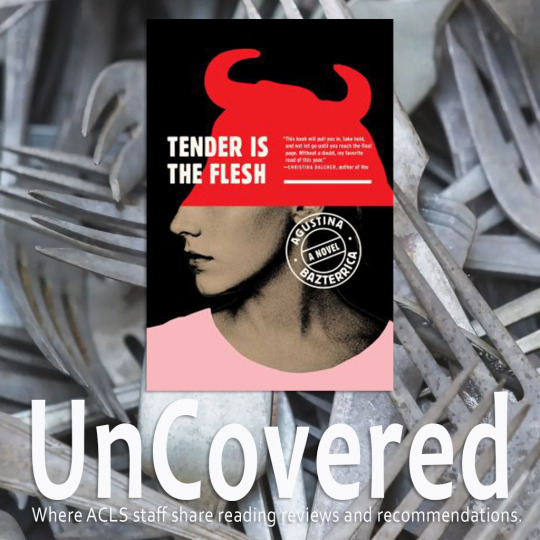
TENDER IS THE FLESH is a dystopian horror story that takes place in a world that appears much like our own, except for the fact that most of the animals have been destroyed due to a virus that is deadly to humans. Following this “Transition” man must find a way to satisfy his hunger for red meat by doing the unthinkable…resorting to cannibalism.
Marcos works at the Krieg Processing Plant where “special meat” is prepared for human consumption, referred to as F.G.P. or First Generation Pure, but which no one will refer to as human. F.G.P. is the most expensive cut of meat, served to the elite as perhaps “a starter of fingers in a sherry reduction” to a “tongue … marinated in fine herbs, served over kimchi and lemon-dressed potatoes.”
When Marcos visits a breeding center, we are confronted with the utter brutality used to make the human livestock more docile. Then at Krieg we are taken step-by-step through the process of slaughtering and packaging the meat for the marketplace. It is all very graphic and very disturbing. Not for the squeamish!
Marcos is then gifted his very own female F.G.P. to devour as he pleases, but instead he starts to grow fond of her, names her Jasmine, and gets her pregnant, which is against the rules. At this point the reader might start to feel a little compassion for Marcos, but we soon find out that his motives are not exactly altruistic.
TENDER IS THE FLESH by Agustina Bazterrica is a quick read (only 224 pages) but the author’s comment on our capitalistic society will stay with you for a long time…what if??
1 note
·
View note
Text
Lincoln and the Fight for Peace
UnCovered Review by Frank Tomasello, ACLS Mays Landing Branch

In his book, LINCOLN AND THE FIGHT FOR PEACE, John Avlon examines the well-known, yet surprisingly little-discussed, two-week trip President Lincoln took to Virginia after the fall of Richmond near the end of the U.S. Civil War. It is often discussed that Lincoln met with Generals Grant and Sherman and others to discuss bring the war to a close and the handling of the post war South, but little is mentioned of the sheer joy Lincoln felt at that time that the terrible war would soon be over and how he enjoyed just simply walking around Richmond (ignoring the obvious danger this placed him in being the most hated man in the South). The book later focuses on Lincoln’s “Let ‘em up easy” approach to future Reconstruction. While acknowledging that an assassin’s bullet prevented that approach from coming to fruition, the author extrapolates that philosophy in later wars involving the United States. Quite validly, the author makes the point that the harsh treatment of Germany after WWI led, in part, to WWII. By contrast, things like the Marshall Plan led to peace in Europe since. Quoting American General Lucius Clay, architect of the post-WWII German occupation, when asked what guided his decisions: “I tried to think of the kind of occupation the South would have had if Abraham Lincoln had lived.”
Unfortunately, the book contains several factual errors, among others, the thoroughly disproven myth, that Lincoln prophesied his imminent death by way of a dream the night before his assassination. This is inexcusable poor research and fact checking which tarnishes an otherwise useful work. Worth reading for the treatment of Lincoln’s happiest moments at the end of the war, which has not be so extensively examined elsewhere.
2 notes
·
View notes
Text
The Covenant of Water
UnCovered Review by Collette Jones, ACLS Egg Harbor City Branch

In 1900, a 12-year-old girl in Travancore, South India, is married off to a 40-year-old widower. She is scared and uncertain, but she knows that she must obey her parents. She sets sail on a boat, leaving her childhood home behind. The girl, who will come to be known as Big Ammachi, grows to love her husband, and they build a life together on their estate, Parambil. Over the next 77 years, Big Ammachi witnesses the birth and death of many family members, as well as the political upheaval of India's independence. She also sees the effects of a family curse that seems to be connected to water: they are haunted, devastated in every generation someone drowns. This book looks into mortality, death and making good decisions. The author reminds us that the beautiful thing about living is the life lived because we and everything else will eventually die. A rose isn’t beautiful because it is a rose it is beautiful because it blooms before it dies.
Dr. Digby Kilgour, a lonely Scottish doctor, flees to India in search of a new life. He soon finds himself caught up in a web of love, betrayal, and scandal. As he struggles to come to terms with his own past, Digby also witnesses the challenges of living in a colonized and segregated society. Through it all, Big Ammachi and Dr. Kilgour are united by their shared humanity. They are both vulnerable and flawed, but they are also capable of great love and compassion. In the end, they find that they are not alone in their struggles. They are all connected by the covenant of water, a bond that transcends time, place, and even death through tears, rivers, and streams they are surrounded.
THE COVENANT OF WATER is a sweeping epic that explores the themes of family, community, and belonging. It is a story of love, loss, and redemption, and it is a reminder that we are all connected, no matter how different we may seem. Through it all, Big Ammachi remains a constant presence. She is a strong and resilient woman who witnesses the best and worst of humanity. She is a reminder that even in the darkest of times, there is always hope. Indian culture, the caste system, British colonialism, illness, poverty intersect in this novel. A lot is going on that needs more attention and explanation. Author Abraham Verghese is a physician. His best writing is when he describes medical conditions, anatomy, surgical procedures, and medical interventions. I would prefer to read a book about the caste system or a book about medical interventions but not in the same novel. The unsuccessful part is that the reader can feel trapped going through over 700 pages. The topics are lively and humorous, but I am left wanting more.
1 note
·
View note